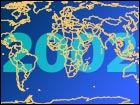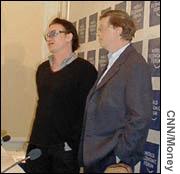|
Davos darkness
|
 |
February 4, 2002: 11:08 a.m. ET
Amid talk of transparency, the WEF meeting was opaque for most media.
By Staff Writer Mark Gongloff
|
NEW YORK (CNN/Money) - Many of the discussions at this year's World Economic Forum meeting concerned "transparency," the idea that markets need to have information about business to function properly.
The WEF meeting, ironically, only grew more opaque as it progressed.
To be fair, the meeting this year was in New York City, its first trip away from the sleepy village of Davos, Switzerland, in its 31-year history. New York is an especially tough place to host a conference or convention, if only because of the sheer numbers of people that show up.
Also to the WEF's credit, its representatives were always exceedingly friendly. They smiled attractively and nodded sympathetically as reporters described dire emergencies.
Then they failed utterly to be helpful in any way.
"This is the shoddiest-run conference I've ever seen!" one reporter shouted Saturday night, directing his wrath at one of the armada of hapless liaisons at the WEF media center.

|
|
|
Bono and Bill Gates bravely confront news-starved reporters. | |
Of course, these complaints were mostly limited to the media. VIPs such as Bill Gates and Bono likely had a pretty easy time of it, aside from confronting mobs of news-starved reporters when they dared set foot in the Hotel Inter-Continental, where most media, prevented from setting foot in the meeting's Waldorf-Astoria venue, were sequestered.
The real news at past WEF meetings happened in the hallways, where heads of state, CEOs, celebrities and reporters bounced into each other with blissful ease. Not so this year. The occasional newsworthy person zipped into the Inter-Continental for press conferences or to tape spots with CNN and other broadcasters, but otherwise it was a Mojave Desert of news.
So dry, in fact, that many reporters packed up and went home early.
"It's been very difficult to find anyone to interview," said Gail Connor of the Associated Press, who had her credentials taken from her for a day when she tried to get into the Waldorf for an interview. "It's been very hard work."
The WEF said it had heard complaints, but said the restrictions were necessary because the Waldorf could not accommodate 3,000 participants and about 850 reporters.
"We elected not to include almost 500 members of the reporting press in the Waldorf because it's a zero-sum game," said Charles McLean, the WEF's director of communications. "They would take the place of government, business, academic and religious leaders. They would have overwhelmed the meeting and taken away many important voices."
A host of snafus
But the WEF worsened matters by failing to broadcast the vast bulk of the workshops and brainstorming sessions at the meeting, where world leaders hammer out consensus about matters of economic and political importance. In these meetings, such trade decisions and organizations as the North American Free Trade Agreement (NAFTA) and the World Trade Organization (WTO) were born.
The WEF agreed to let the press watch a handpicked few of these events via a live feed from the Waldorf. Of course, the first day's broadcasts were totally without sound, but who wants to look a gift horse in the mouth?
| |

|
|
The WEF media desk, where reporters' problems were busily unsolved. | |
After a day of utter silence, barely audible sound began to creep into the broadcasts, and, by Friday, the sound was loud and clear. By Saturday morning, the WEF was so pleased with its newfound ability to transmit sound that it took to occasionally punctuating the dead-air time between broadcasts with head-splitting digital shrieks.
Unfortunately, the strain of transmitting sound apparently blew a gasket in the WEF's machinery, so that, by Saturday afternoon, no meetings were being transmitted at all.
"Expect delays of one and a half hours," before broadcast, read a hand-written sign by the doorway of the press center.
A media liaison, when pressed for details about the delay, could not say when the two most interesting broadcasts of the day would actually occur. He could not even say if the delay would be less than an hour and a half, which meant that reporters would have to camp out in the media center indefinitely if they wanted to watch any meeting.
"I don't want to say [a definite time], and have you miss it," the blushing liaison said.
After a delay of more than five hours without a broadcast, another WEF representative helpfully pointed out that the workshops were available as Webcasts on the WEF's site.
But there were no Webcasts available. A WEF representative working for the Web site apologized for not having Webcasts, citing infrastructure problems. In fact, the site was inaccessible for a day and a half, the result of unexpected traffic caused in part by protesters generating thousands of hits to slow it down.
McLean acknowledged there had been some "snafus," but pointed out that the WEF is a non-profit group with a very small staff. His media relations department, for example, had only six full-time workers.
"We have tried to do our best to make this a useful experience for the press," McLean said. "I think our media team, frankly, has done an incredible job. I think they've worked miracles."
A shortage of real news
At the meeting, many media liaisons were temporary hires, and they were woefully uninformed. When pressed late Saturday night about the possible broadcast time of a workshop, one said, "It's playing right now in the media center." A quick peek around the corner was enough to confirm that it was not. It never did air, though it may someday be available on the WEF Web site for viewing by historians.
In place of actual access to the workshops, the WEF kindly provided written "summaries" of them. On the first day of the conference, they said the summaries would be available "about an hour and a half" after each workshop. The lag time was actually more like 24 hours when they materialized at all, and their one-page length was inadequate to convey the ideas expressed in workshops that lasted more than an hour.
When workshops were broadcast, they were, more almost always the least newsworthy events of the day.
"They're showing us things we normally wouldn't cover. I'm getting second-hand stories," said Jose Passos, Washington, D.C. correspondent for O Globo, a news daily based in Rio de Janeiro, Brazil. "What can I do? I have to rely on wire services."
Of course, two other papers from Brazil did get access to the Waldorf, so their reporters were able to cover the workshop; the WEF should get credit for not keeping the public completely in the dark. They also provided useful table space, outlets, phone lines, fax machines and refreshments to the media trapped in the Inter-Continental.
"This is better for the working press than it was in Davos," said Robert Corrigan, media relations manager at Merrill Lynch Europe. "They didn't have a media center there; they were just scattered in various hotels."
But it was a bit insulting for the WEF to proudly decorate that same media center with copies of New York Times articles about discussions in some of the workshops, including Friday's report of Colin Powell's newsworthy comments on terrorism - made in a workshop that the majority of the world's press didn't get to see, which will never be available on the WEF Web site and which was not adequately summarized in the one-page release issued by the WEF.
And it's uncertain if next year's return to Davos will make life any easier for the press. McLean said the WEF planned to examine how its system worked this year and decide then how much access to allow reporters at the next meeting. 
|
|
|
|
|
|

|

